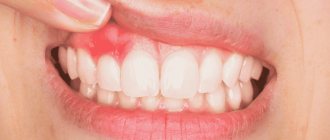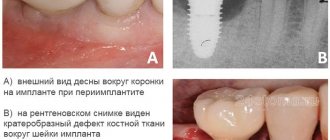Flux is one of the most unpleasant phenomena in dental practice. It is a growth with purulent contents located on the gum. The tumor is formed due to inflammation of the periosteum. As a rule, it occurs against the background of advanced dental diseases.
Did flux form after installing the filling? Are your gums swollen and painful? In this case, you should contact your doctor or another dentist as soon as possible. Do not delay your visit to a specialist to prevent the development of more serious complications.
Causes of dental periostitis
In dentistry, gumboil is commonly called periostitis of the jaw. According to statistics, this disease is diagnosed in approximately 5% of patients. In most cases, the infectious-inflammatory process affects the lower jaw and occurs in an acute form.
Periostitis can be provoked by:
- chronic periodontitis - prolonged inflammation of the periodontal tissues,
- alveolitis - infection of the socket after tooth extraction,
- jaw cyst is a benign neoplasm with liquid contents,
- complicated wisdom tooth eruption,
- mechanical damage to the jaw,
- sore throat, flu, acute respiratory viral infections,
- dentist mistakes when cleaning tooth canals and filling.
After installing a filling, flux may form due to hidden inflammation. When a toothache occurs, many patients take painkillers rather than see a doctor. Tablets eliminate pain, but not its cause.
Causes of cheek swelling
- First of all, a swollen cheek is a result of the treatment itself. The swelling normally goes away within a few hours after a visit to the dentist.
- A swollen cheek is often a consequence of the anesthetic used. This indicates that the patient is allergic to the drug administered to him. The patient may experience slight itching and pain in the area where the injection was given.
- Swelling of the cheek is a consequence of dental canal treatment. Sometimes during treatment, the drug penetrates the mucous membrane, which causes inflammation. As a rule, the doctor notices the swelling and takes action in the dental office. But such a situation in itself arises extremely rarely.
- Most often, a patient observes that his cheek is swollen after surgical tooth extraction. This is normal, since when a tooth is removed from its socket, blood vessels rupture. Violation of the integrity of the blood vessels leads to the fact that the cheek swells a little. The doctor must warn the patient about the consequences before the removal procedure. After the procedure, the dentist gives recommendations to the patient that help relieve swelling of the cheek and reduce pain. The condition returns to normal within 4-5 hours.
- The cause of cheek inflammation may be unsterile instruments used during treatment. The inflamed condition in this case is the result of infection entering the treated tooth. This can lead to inflammation of the airways and alveolitis.
If inflammation in the cheek does not go away within 2-3 days, be sure to consult a doctor. The sooner you contact your dentist, the faster he will eliminate the cause of the swelling and prevent serious consequences, such as gum suppuration. If pus has already formed, the dental surgeon will make an incision to eliminate the source of inflammation.
Clinical picture
A clear sign of gumboil is a lump on the gum with purulent contents. Before its formation, the disease makes itself felt by throbbing pain in the tooth. Symptoms of the pathology are also:
- swelling and redness of the gums,
- swelling of the cheek or lip,
- enlarged lymph nodes,
- pain when opening the mouth and swallowing,
- discomfort when pressing on a tooth,
- increase in body temperature,
- excessive weakness
- decreased appetite.
If you detect at least one of the listed signs of flux, you should contact the dentist. You should not warm the sore spot with a warm compress, take antibiotics without a doctor’s prescription, or open an abscess at home.
Why does a tooth hurt so much after nerve removal?
Serious complications after depulpation can arise due to a medical error or an unpredictable reaction of the body.
The most popular causes of severe pain after dental nerve removal:
- removal of filling material beyond the root;
- improperly sealed canal;
- a fragment of an instrument remained in the canal;
- root perforation;
- allergy to the filling material.
To avoid errors in treatment, dentistry for nerve removal must be chosen very responsibly. The ART-Dent clinic employs only highly qualified specialists, so the risk of undesirable consequences is minimized.
Diagnosis and treatment
To make a diagnosis, the doctor only needs to examine the oral cavity and study an X-ray of the jaw. The flux treatment regimen is compiled individually for each patient. This may include:
- complex treatment of caries, pulpitis or periodontitis,
- taking antibacterial drugs,
- opening the abscess and draining the contents,
- rinsing the mouth with antiseptic solutions,
- physiotherapy - UHF, laser therapy, electrophoresis.
What could be the reason?
1. Individual reaction of the body to root canal treatment,
2. Inaccuracies in medical work.
And if your body’s physiological response to medical intervention is almost impossible to predict, all that remains is to focus on reducing potential risks during root canal treatment.
High-quality root canal treatment – what is it?
Yes, endodontic treatment (root canal treatment) is a rather complex dental procedure. To perform it well, you need precise manual skills of a doctor, an understanding of the mechanisms of pulpitis and periodontitis, and most importantly, compliance with protocols and treatment techniques.
Causes of pain after root canal filling
Principle No. 1 - sterility
One of the key principles in root canal treatment is to achieve relative sterility in the tooth canals. There is no way to completely get rid of microorganisms, but a doctor is quite capable of reducing the number of bacteria to the minimum level that the immune system can cope with.
To ensure sterility in the root canals, the dentist uses a rubber dam, this is a special latex scarf. Using a rubber dam, the doctor isolates the desired tooth from the rest of the mouth, which prevents saliva and bacteria from entering the root canals.
And to destroy bacteria that are already inside the root canals, the dentist repeatedly rinses the canals with sodium hypochlorite.
Principle No. 2 – full channel processing
In order to seal the canals and even to thoroughly rinse them with an antiseptic solution, you must first go through each canal for its entire length. Then, give the channels the required shape and expand them to the optimal size. For this purpose, the dentist-therapist has special tools in his arsenal, similar to thin flexible needles. They can be manual or machine. The best result is obtained by their combination.
Principles in root canal treatment
When treating root canals, KANO clinics use the X-SMART Plus endodontic micromotor and the Endo-Mate TC2 endodontic micromotor. This helps the doctor to process the canals quickly and reliably - because sodium hypochlorite does not get into the under-expanded root canals and bacteria can remain there. A tooth full of microorganisms is doomed to bother you again over time - and even cause removal with subsequent implantation.
Principle No. 3 – control of treatment at all stages
When performing root canal treatment, the dentist can only see the mouth - the very beginning of the root canal. And the rest of the canals are hidden from view inside the tooth root. Therefore, visualization tools play a special role in endotherapy: an X-ray machine and an apex locator.
1. X-ray control should be carried out before, after and during root canal treatment. Don't worry - you won't receive excessive radiation exposure, because during targeted images the radiation dose is very small (1.5-3.3 mSv).
2. Use of an apex locator - a special device for determining the length of the root canal during treatment. This allows the dentist to work only in the dental canal, without going into the peri-root tissue, and to minimize the patient’s pain - both during and after treatment.
Tooth hurts after root canal filling: what not to do
If the doctor controls the canal treatment process and does not work blindly, then the likelihood of post-filling pain is reduced significantly.
What not to do if your tooth hurts after root canal filling:
- Do not heat the tooth or steam it with hot water.
- You cannot cool an aching tooth or keep ice near it.
- Do not apply propolis, cotton wool soaked in essential oils, valocordin or any other substance to the tooth. Unfortunately, you can read about such methods on the Internet, but you absolutely cannot do this: at best there will be no effect, and at worst, you will have a burn to the mucous membrane.
- You should not try to open a temporary or permanent filling yourself.
Tooth hurts after root canal filling: what to do
Brief conclusions
The main consequences of poor treatment of pulpitis are as follows:
- flux, formation of cysts in cases where the canals are not completely filled, periodontitis;
- prolonged pain and neuralgia during repeated canal filling.
One of the most unpleasant consequences for the patient is tooth extraction. It cannot be avoided if:
- the doctor during the treatment broke the root or caused a perforation, which was not eliminated as soon as possible;
- A periodontal abscess formed at the root apex, and the patient delayed its treatment.
A tooth hurts due to a poorly filled canal
A feeling of pain and swelling of the gums are the first signs that the tooth treatment was performed poorly. However, there are situations when the inflammatory process develops slowly, and it is possible to understand that something is wrong with the tooth only by taking a picture.
As mentioned above, filling canals is a common procedure, often performed with errors: if they are not corrected, then after some time inflammation and, consequently, pain will begin.
There are the following options for unsatisfactory filling:
- The canal was not sealed to the entire length of the root. The pulp becomes inflamed due to microorganisms that have entered it. After its removal and thorough treatment of the canal with drugs, some part of the microflora still remains. When the canal is not filled along its entire length or the filling material is not compacted tightly, the infection multiplies and affects the tissue surrounding the tooth. Eventually, a sac filled with pus appears at the apex of the root. If the doctor has not completely filled the canal, then the tooth must be re-treated (the sooner this is done, the greater the chances of saving it). Usually, a complete unfilling of the canal and its re-sealing is required. When the canal is unsealed only in the area of the upper part of the root, the doctor can perform a resection, which allows the canal not to be unsealed.
- Exit of filling material beyond the root apex. One of the causes of pain is the removal of the material used for filling beyond the upper part of the root. There is no universal method for eliminating the deficiency: a preliminary examination by a doctor is required. If little material has been removed, the pain will subside over time (in some cases you will have to wait up to 2 months). In this case, the patient is given a choice: either tolerate a slight reduction in pain, or agree to re-treat the tooth. If a lot of material has been removed, surgical intervention will be required: the doctor will make a small hole in the bone through which he can remove excess material (a simple operation takes about half an hour).
- Leaving a broken part of a medical instrument in the canal. When processing the canal, the instruments used by the doctor may break off. There may be several reasons for this: careless actions of the dentist; curved channels. Sometimes it is possible to get a fragment out, but if a piece of the instrument remains in the upper third of the root, it becomes very difficult to remove it. The broken part does not allow filling the entire length of the canal. There is a risk of infection multiplying, which can provoke the development of an inflammatory process in the tissues surrounding the tooth.
- Root perforation. Perforation is a small hole that appears in the root either due to natural causes (excessive curvature of the canals, but this happens rarely), or due to the actions of a doctor. Today, perforation is a very intractable problem in dentistry. Most often, perforation occurs when a pin is installed, when it is not fixed in the canal, but is brought out through its wall directly into the bone. If the canal is very curved or difficult to navigate, then working in it requires great precision from the doctor. But even extreme accuracy does not guarantee that mistakes will be avoided. Often, high-quality treatment of curved canals becomes a difficult task for an experienced doctor.
Perforation can be corrected, but it is difficult to do. To properly close the hole, expensive materials like Pro Root MTA are used. Sometimes filling with this material can be done from the inside of the tooth, sometimes surgical access to the area where the perforation has occurred is required. If the doctor is to blame for its appearance, then the hospital must correct the shortcomings at its own expense.
Methods for relieving pain after tooth nerve removal
There is no need to worry if the tooth hurts when pressed and tapped, reacts to cold and hot, or discomfort occurs when the jaws are completely closed. You need to take pain medication after tooth nerve removal, which will be prescribed by your doctor. Usually these are Ketorol, Nimesil, Tempalgin, etc. Rinsing your mouth with water, baking soda, salt and iodine will help relieve minor pain.
If gum inflammation, fever, and pus discharge are added to the pain after nerve removal, you should consult a doctor.
First aid for inflammation
It is better to use any medications to combat pathological symptoms after consulting a doctor, since all medications in this group have different compositions and a list of contraindications. At home, you can use various rinses as first aid before going to the dental clinic. They are not recommended for use for more than two days, since the absence of qualified assistance for a long period of time can worsen the patient’s condition and lead to the progression of the pathology.
Calendula decoction with salt
Calendula flowers have a disinfectant, antimicrobial and healing effect
Calendula is one of the most famous medicinal plants. Calendula flowers (marigolds) have a disinfectant, antimicrobial and healing effect, so a decoction of this plant helps to quickly cope with inflammation and speed up the healing of soft tissues. If you add salt to the decoction, you can improve the condition of the gums during purulent inflammation, since any salt perfectly draws out pus and ensures the outflow of exudate.
To prepare a medicine to treat inflammation, you must:
- Pour 100 g of calendula flowers into 700 ml of boiling water and put on low heat;
- cook for 15-20 minutes;
- add a tablespoon of salt and cook for another 5 minutes;
- leave for an hour and strain.
You should rinse your mouth with this decoction 3 to 10 times a day (depending on the degree of inflammation). Symptoms usually become less noticeable on the second day of use.
Bread crumb infusion
Bread crumb infusion is a simple and effective remedy for treating gum inflammation.
If you don’t have medicinal plants at hand, you can use a very simple but effective recipe and prepare an infusion from bread pulp. You can use any type of bread made from rye or peeled flour, as they contain a large amount of minerals and vitamins that have a positive effect on the condition and health of the gums.
Preparing the infusion is very simple:
- break one piece of bread (approximately 50-70 g) into small pieces and place in a shallow container;
- pour 300 ml of boiling water and add half a spoon of salt;
- leave for 5-7 minutes and cool.
You should rinse your mouth with this infusion 3-5 times a day. The product perfectly helps with any inflammatory processes, pain after treatment and tooth extraction, as well as at the initial stage of purulent-infectious processes.
Video - How to treat gum disease
- How to deal with unpleasant odors in the home of a seriously ill person










